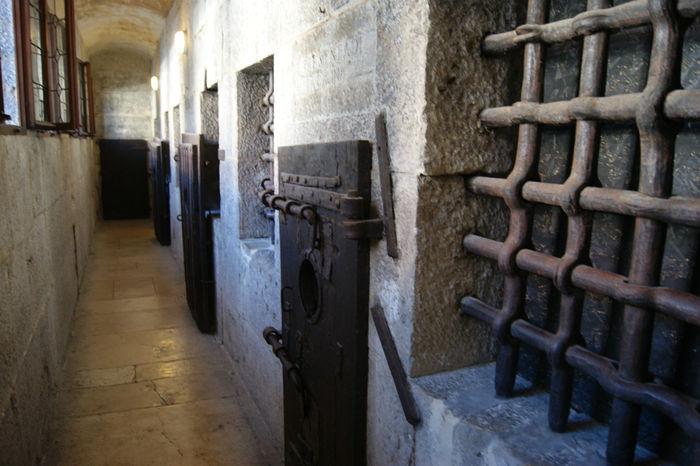Inside the Prisons of the Venice Republic: Piombi and Pozzi
ITA:

Ever heard of the ‘Piombi’ and the ‘Pozzi’? They were the prisons of the Venice Republic, located inside the Doge’s Palace.
The Piombi’s name, ‘lead’ in Italian, refers to the lead covering the roof. In the winter season, this caused the cold to filter through; in the summer time, it attracted the heat. This contributed to making the living conditions for prisoners worse.
These cells were used exclusively for those sentenced by the Council of Ten, which was, from 1310 to 1797, one of the major governing bodies of the Republic of Venice. The Piombi were reserved for those accused of political crimes, those awaiting sentence or those serving short prison terms. They were located directly under the roof.
Prisoners were allowed to walk down the hallway that connected the various cells during their hour ‘outside’.
Perhaps the Piombi’s most famous prisoner, Giacomo Casanova was one of the very few, along with a renegade priest who fled with him, Father Balbi, to escape the prison in 1756, an event he would later recount in Story of My Flight, published in 1787.
The Piombi offered worse conditions than the ‘New Prisons’, but better ones than those in the ‘Pozzi’ (wells), the prisons located on the ground floor of the Doge’s Palace. Consisting of damp, tiny cells, barely lit by oil lamps, and ventilated only through round holes in thick stone walls, the Pozzi were truly terrible, as inmates themselves wrote on the walls through desperate messages longing for freedom. In each cell there was a shelf for the few things the detainee could keep and a wooden bucket with a lid to contain human excrement.
The Old Prisons inside the Doge's Palace were later supplemented by the New Prisons, built across the Rio de Palazzo from the palace at the beginning of the 17th century. The New Prisons were connected to the Old Prisons by the much-photographed Bridge of Sighs.
If you have a penchant for haunted places, Palazzo Ducale’s Secret Itineraries Tour takes you to both the Pozzi and the Piombi.
Hai mai sentito parlare dei 'Piombi' e dei 'Pozzi'? Erano le prigioni della Repubblica di Venezia, e si trovavano all'interno di Palazzo Ducale.
Il nome Piombi si riferisce al piombo che ricopriva il tetto. Nella stagione invernale, il piombo lasciava filtrare il freddo, mentre in estate attirava il calore, contribuendo a rendere le condizioni di vita per i prigionieri peggiori.
Le celle dei Piombi erano utilizzate esclusivamente per i condannati dal Consiglio dei Dieci, che fu, dal 1310 al 1797, uno dei principali organi di governo della Repubblica di Venezia. I Piombi erano riservati a coloro che erano accusati di reati politici, a quelli in attesa di giudizio o a quelli che servivano pene detentive brevi. Erano situati direttamente sotto il tetto.
I prigionieri potevano camminare lungo il corridoio che collegava le varie celle durante l’ora d’aria.
Forse il più famoso prigioniero dei Piombi, Giacomo Casanova fu anche uno dei pochissimi, insieme a un prete che fuggì con lui, padre Balbi, a evadere dal carcere. Ciò avvenne nel 1756, un evento che racconterà in Storia della mia fuga dai piombi, pubblicato nel 1787.
I Piombi avevano condizioni peggiori rispetto alle ‘Prigioni Nuove’, ma comunque migliori di quelle nei ‘Pozzi’, le prigioni situate al piano terra del Palazzo Ducale. Qui le piccole e umide celle erano appena illuminate da lampade a olio, e ventilate solo attraverso fori ricavati dalle spesse mura di pietra; le condizioni nei Pozzi erano davvero terribili, come i detenuti stessi hanno scritto sulle pareti, dove hanno lasciato messaggi disperati e desiderosi di libertà. In ogni cella, c'era un ripiano per le poche cose che il detenuto poteva tenere con sé e un secchio di legno con un coperchio per gli escrementi.
Alle vecchie prigioni all'interno di Palazzo Ducale sono state successivamente aggiunte le Prigioni Nuove, costruite al di là del Rio de Palazzo all’inizio del Seicento. Erano collegate alle vecchie prigioni dal fotografatissimo Ponte dei Sospiri.
Se hai un debole per i luoghi spettrali, Palazzo Ducale organizza il tour Itinerari Segreti, che porta a visitare sia i Pozzi che i Piombi.











